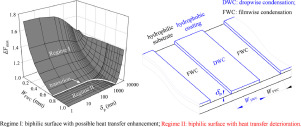当前位置:
X-MOL 学术
›
Int. J. Heat Mass Transf.
›
论文详情
Our official English website, www.x-mol.net, welcomes your feedback! (Note: you will need to create a separate account there.)
Mixed dropwise-filmwise condensation heat transfer on biphilic surface
International Journal of Heat and Mass Transfer ( IF 5.2 ) Pub Date : 2020-04-01 , DOI: 10.1016/j.ijheatmasstransfer.2019.119273 Jian Xie , Qingting She , Jinliang Xu , Cong Liang , Wenxiao Li
International Journal of Heat and Mass Transfer ( IF 5.2 ) Pub Date : 2020-04-01 , DOI: 10.1016/j.ijheatmasstransfer.2019.119273 Jian Xie , Qingting She , Jinliang Xu , Cong Liang , Wenxiao Li

|
Abstract Condensation heat transfer on biphilic surface is investigated. The surface periodically populates hydrophobic stripes each having a coating layer thickness δp and a width WDWC, and hydrophilic stripes each having a width WFWC. The proposed model includes dropwise condensation on hydrophobic stripe, filmwise condensation on hydrophilic stripe, and droplet detachment radius rmax criterion for heat-mass coupling between the two wettabilities regions. The rmax is the minimum of detachment radii determined by droplet removal modes of double-sides-suction DSS, one-side-suction OSS and sliding, where DSS is a special case of OSS for droplet located at hydrophobic stripe centerline. Simulation results matched the measured heat transfer data well. Optimal width of hydrophobic stripe W DWC o is found to be dominated by δp and WFWC, but other parameters weakly influence W DWC o . Interfaced by a δp−WFWC transition curve, a heat transfer regime map is presented to contain Regime I for possible heat transfer enhancement and Regime II for heat transfer deterioration. Regime I enhances heat transfer if WDWC approaches W DWC o , but may deteriorate heat transfer if WDWC deviates W DWC o too much. The maximum heat transfer enhancement ratio is 1.67 compared with purely hydrophobic surface. Regime II always deteriorates heat transfer. Our work provides a general guideline to design biphilic surface for performance improvement.
中文翻译:

双亲表面上的混合滴膜状冷凝传热
摘要 研究了双亲表面的冷凝传热。表面周期性地填充各自具有涂层厚度δp和宽度WDWC的疏水条纹,以及各自具有宽度WFWC的亲水条纹。所提出的模型包括疏水条纹上的滴状冷凝、亲水条纹上的薄膜状冷凝以及两个润湿性区域之间的热质量耦合的液滴脱离半径 rmax 标准。rmax 是由双侧吸 DSS、单侧吸 OSS 和滑动的液滴去除模式决定的最小脱离半径,其中 DSS 是位于疏水条纹中心线的液滴的 OSS 特例。模拟结果与测得的传热数据匹配良好。发现疏水条纹的最佳宽度 W DWC o 由 δp 和 WFWC 主导,但其他参数对 W DWC o 的影响很小。通过 δp-WFWC 过渡曲线,呈现了一个传热状态图,其中包含用于可能的传热增强的状态 I 和用于传热劣化的状态 II。如果 WDWC 接近 W DWC o ,则制度 I 会增强传热,但如果 WDWC 偏离 W DWC o 太多,则可能会恶化传热。与纯疏水表面相比,最大传热增强率为1.67。状态 II 总是会恶化传热。我们的工作为设计双亲表面以提高性能提供了一般指南。如果 WDWC 接近 W DWC o ,则制度 I 会增强传热,但如果 WDWC 偏离 W DWC o 太多,则可能会恶化传热。与纯疏水表面相比,最大传热增强率为1.67。状态 II 总是会恶化传热。我们的工作为设计双亲表面以提高性能提供了一般指南。如果 WDWC 接近 W DWC o ,则制度 I 会增强传热,但如果 WDWC 偏离 W DWC o 太多,则可能会恶化传热。与纯疏水表面相比,最大传热增强率为1.67。状态 II 总是会恶化传热。我们的工作为设计双亲表面以提高性能提供了一般指南。
更新日期:2020-04-01
中文翻译:

双亲表面上的混合滴膜状冷凝传热
摘要 研究了双亲表面的冷凝传热。表面周期性地填充各自具有涂层厚度δp和宽度WDWC的疏水条纹,以及各自具有宽度WFWC的亲水条纹。所提出的模型包括疏水条纹上的滴状冷凝、亲水条纹上的薄膜状冷凝以及两个润湿性区域之间的热质量耦合的液滴脱离半径 rmax 标准。rmax 是由双侧吸 DSS、单侧吸 OSS 和滑动的液滴去除模式决定的最小脱离半径,其中 DSS 是位于疏水条纹中心线的液滴的 OSS 特例。模拟结果与测得的传热数据匹配良好。发现疏水条纹的最佳宽度 W DWC o 由 δp 和 WFWC 主导,但其他参数对 W DWC o 的影响很小。通过 δp-WFWC 过渡曲线,呈现了一个传热状态图,其中包含用于可能的传热增强的状态 I 和用于传热劣化的状态 II。如果 WDWC 接近 W DWC o ,则制度 I 会增强传热,但如果 WDWC 偏离 W DWC o 太多,则可能会恶化传热。与纯疏水表面相比,最大传热增强率为1.67。状态 II 总是会恶化传热。我们的工作为设计双亲表面以提高性能提供了一般指南。如果 WDWC 接近 W DWC o ,则制度 I 会增强传热,但如果 WDWC 偏离 W DWC o 太多,则可能会恶化传热。与纯疏水表面相比,最大传热增强率为1.67。状态 II 总是会恶化传热。我们的工作为设计双亲表面以提高性能提供了一般指南。如果 WDWC 接近 W DWC o ,则制度 I 会增强传热,但如果 WDWC 偏离 W DWC o 太多,则可能会恶化传热。与纯疏水表面相比,最大传热增强率为1.67。状态 II 总是会恶化传热。我们的工作为设计双亲表面以提高性能提供了一般指南。


























 京公网安备 11010802027423号
京公网安备 11010802027423号